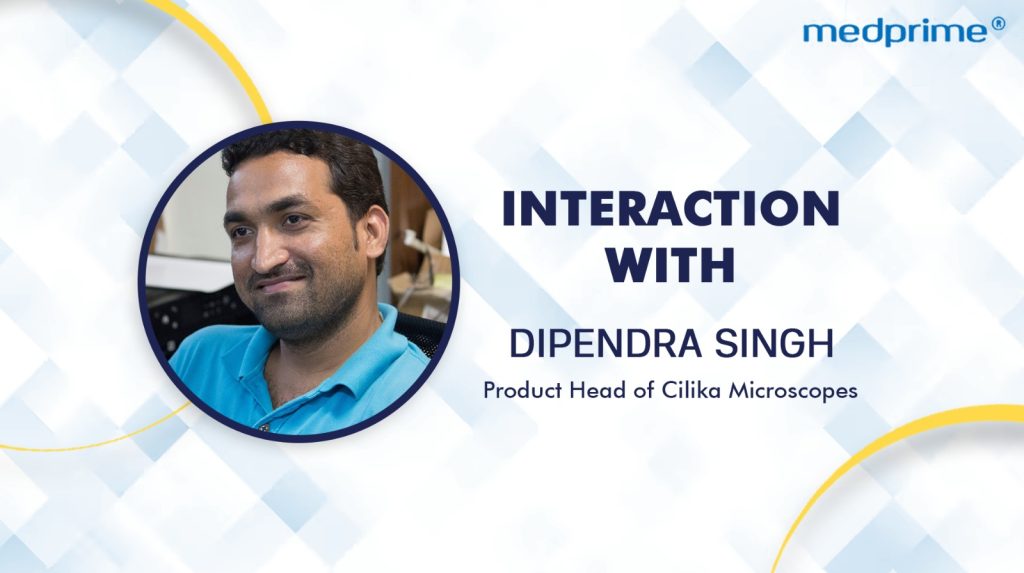Microscopy has undergone significant transformations in the recent past. Microscopes have become more efficient, ergonomic, digitized, and therefore, even more, productive and intelligent. But transformations don’t happen at the drop of a hat or on their own. There are teams contributing their intellect and efforts to make things happen!
Medprime is one such company working dedicatedly in the field of microscopy. It is one of the leading companies in the microscopy realm that delivers value to its clients and the industry with innovative products that set benchmarks. But what is Medprime’s secret sauce to success? Let’s hear it from Dipendra Singh Bhadauriya, Product Head at Medprime.
Can you share your background and experience in microscopy?
I hold a master’s degree in product design and development and have been working in the realm of microscopy for over seven years. I have been part of Medprime Technologies since its early days and participated in designing and developing various innovative products like IV monitoring systems, digital portable and benchtop microscopes, etc. As the product head for Cilika microscopes, I focus more on user-centricity, as it is users’ satisfaction, positive feedback, and value that matters to us, as a team, the most!
What are the most important factors when designing and developing a new microscope product?
Honestly, there are many. But the most significant ones include uniqueness and usefulness. Your target clients won’t adopt a particular technology or idea doesn’t add value to the market. For instance, when we developed the portable microscope, we had a certain purpose and holistic objective in mind. The aim wasn’t merely enhancing image quality but also to take advanced microscopy to the country’s rural areas, where the absence of such technologies affects overall healthcare and makes it more challenging.
Besides, while developing a new product, we carefully review conventional challenges. Here, I can give you an example of our TrueView technology. With traditional microscopes, capturing 100% of the circular field was impossible. But we made it possible through the patented TrueView technology. A comprehensive, 100% circular view can support better and more accurate observation and diagnosis.
Some others include illumination, ergonomics, and cost-effectiveness. In a nutshell, the idea is to enhance microscopy, provide clearer and better-resolution images, reduce physical stress in microscopy-related work, and keep the product affordable to meet the needs of a broader target audience and serve more end beneficiaries.
Can you discuss any recent innovations or advancements in microscope technology your company has been working on?
Currently, we are working on automated microscopes. We have been working on a digital whole slide scanner. The intention is to make whole slide scanning affordable as it is currently an expensive technology and therefore it is not viable for a small- to mid-size lab to adopt it. So, we intend to make this technology affordable to every lab, regardless of its size, through our product. Another factor is including a joystick to help the pathologist control the microscope’s movement as per their needs.
We’ve already launched our initial version of the whole slide scanner. So, we are now working on introducing its advanced version.

How do you stay abreast of the latest trends and developments in microscopy?
Our primary source of staying updated with the industry’s latest trends and advancements in conferences and events. But in addition, I read many printed and e-magazines, journals, and industry-specific news to know what’s happening around me. For instance, I recently attended NTLF, a NASSCOM, wherein I met many industry peers and discussed new technologies and the future of microscopy in India. (Read more – The Bright Future Of Digital Microscopy)
Can you walk us through the process of bringing a new microscope product to market, from concept to launch?
The first step is market research. It involves understanding existing products, their benefits, drawbacks, and also the customer’s needs and response. We devise solutions based on what’s there and what’s not in the market and what our target segment precisely requires to resolve contemporary and futuristic challenges.
We then conceptualize an idea and screen it. It also involves a lot of brainstorming so that the best comes out. After that, we finalize a concept and create a plastic or a 3D print prototype. Then comes testing the prototype. If the prototype passes the test, we take it to the pathologist, gather feedback, note modifications, redesign and finalize the product. Once the product is finalized, we send it for metal manufacturing.
How do you prioritize which features to include in your microscope products, and what factors do you consider when making those decisions?
There are many. But what we fundamentally focus on is challenges, solutions, and value. We ask ourselves whether we are resolving existing challenges and providing customers with a better alternative. Will our solution deliver the value pathologists and doctors expect from it? How useful, time and cost-saving will our product be, etc.?
These days, pathologists use various platforms for interactions. Accordingly, we endeavor to have our microscopes compatible with those platforms while enabling the tele-pathology to aid effective learning and remote diagnosis.
In addition, we’ve come up with digital magnification and real time projection on LED screens; which enhances the teaching purpose.
With our products, we not only intend to improve the technical aspects of the profession, but also make life easier for pathologists. Experts spend hours bending in front of the microscope to view slides, thus straining their eyes and spinal cord. The ergonomic design of our microscopes allows them to view the slide comfortably at the eye level, thus eliminating the need to bend.
Besides, unlike conventional microscopes which were either immovable or required a herculean effort to carry, ours are lighter and can be easily taken anywhere to perform onsite diagnosis, thus saving time, resources and effort in transporting the slides.
We look for answers and build products that prove useful to our clients and offer complete value for money. Additionally, our organized process that involves ideation to manufacturing enables us to make informed decisions about the features to prioritize in our products and deliver what it takes to delight our clients.
How do you ensure that your microscope products meet the needs and expectations of your customers?
The most significant part here is empathy. I think empathy drives everything. When you put yourself in the client’s shoes and think like them, you’ll get all your answers. We are here for our customers. So, when we know what they want, we are already halfway through. We fulfill the next half through research, innovation, and development.
But another vital aspect is our aftersales service. We handhold our customers throughout. Whether it is a service-related call or a technical concern, our experts are prepared to attend to the client and provide accurate solutions.
What are your thoughts on the future of microscopy, and where do you see the industry heading in the coming years?
Somehow, I feel, microscopy has remained ignored for the past two decades, with little or no innovative research. But factors like changing times and the healthcare sector’s evolving needs have brought microscopy into the limelight. Digital microscopy, as I see it, is a game-changing innovation. Since it is in its primitive phase, it will evolve and emerge stronger, with it penetrating deprived countries across Asia and Africa.
Another important part of microscopy’s future is AI-based technology. One simple yet significant example is counting WBCs. AI-powered microscopy enables pathologists to automate counting the number of different types of WBCs. It eliminates the efforts required in manual counting and also reduces the time incurred in performing tasks manually.
What advice would you give to someone just starting out in the microscope industry or interested in pursuing a career in this field?
The microscopy industry is massive and has employment and entrepreneurship opportunities for everyone. But as it holds true in the case of other industries, you should develop the capability to think from the client’s perspective and focus on devising empathetic, useful, sustainable, and affordable solutions. Enter this industry with a holistic and optimistic purpose. There’s so much to do here. All you need to do is keep your eyes and ears open and do what it takes to make a positive difference.
Visit https://www.medprimetech.com/ to learn more about the company’s products.
